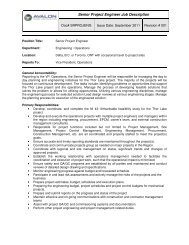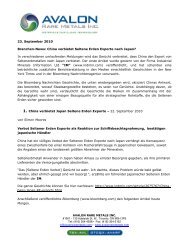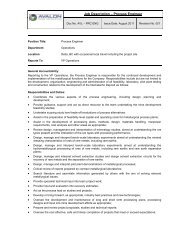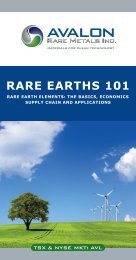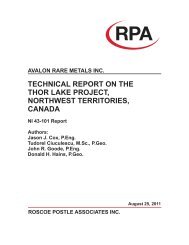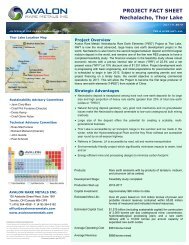technical report on the nechalacho deposit, thor lake project ...
technical report on the nechalacho deposit, thor lake project ...
technical report on the nechalacho deposit, thor lake project ...
You also want an ePaper? Increase the reach of your titles
YUMPU automatically turns print PDFs into web optimized ePapers that Google loves.
A high R 2 (and all regressi<strong>on</strong>s had significant p-values) for <strong>the</strong> regressi<strong>on</strong>, coupled with a high<br />
p-value in <strong>the</strong> t-test reinforces <strong>the</strong> significance of <strong>the</strong> correlati<strong>on</strong> between <strong>the</strong> Nit<strong>on</strong> instrument<br />
and <strong>the</strong> laboratory results.<br />
A high R 2 coupled with a low p score <strong>on</strong> <strong>the</strong> t tests indicates that <strong>the</strong>re is poor numerical<br />
correlati<strong>on</strong> between <strong>the</strong> Nit<strong>on</strong> instrument and <strong>the</strong> laboratory results, but a good fit <strong>on</strong> a<br />
regressi<strong>on</strong> line, implying that <strong>the</strong> variati<strong>on</strong> in <strong>the</strong> Nit<strong>on</strong> reading is proporti<strong>on</strong>al to <strong>the</strong> laboratory<br />
estimate but <strong>the</strong>re is a systematic percent bias in <strong>the</strong> Nit<strong>on</strong> readings (ei<strong>the</strong>r high or low).<br />
Note that handheld XRF units can suffer precisi<strong>on</strong>, bias or general inaccuracies when<br />
measuring extremes of c<strong>on</strong>tents – ei<strong>the</strong>r very high or very low levels of an element.<br />
Aval<strong>on</strong> c<strong>on</strong>cluded that Nit<strong>on</strong> XRF analysis has been dem<strong>on</strong>strated to reflect laboratory analyses<br />
for <strong>the</strong> elements Y, Ce, Ne, Sm and Gd. Fur<strong>the</strong>rmore, with more effort in instrument calibrati<strong>on</strong>,<br />
acceptable results can be achievable for Ta and Zr. These c<strong>on</strong>clusi<strong>on</strong>s are significant in that<br />
<strong>the</strong> relative amounts of light and heavy rare earths are reas<strong>on</strong>ably represented by<br />
measurements of Ce and Y. Thus, <strong>the</strong> total rare earth grade and light rare earth (LREE)<br />
c<strong>on</strong>tent can be estimated using <strong>the</strong> Ce values and <strong>the</strong> relative proporti<strong>on</strong> of heavy rare earths<br />
(HREE) can be estimated using <strong>the</strong> Y grade. This can be supported in <strong>the</strong> case of LREE by <strong>the</strong><br />
Nd values and in <strong>the</strong> case of HREE by <strong>the</strong> Gd values.<br />
NITON HANDHELD ANALYZER FOR GRADE AND QUALITY<br />
CONTROL<br />
Given <strong>the</strong> test results summarized above for using <strong>the</strong> Nit<strong>on</strong> handheld analyzer <strong>on</strong> drill core, its<br />
use in mining grade c<strong>on</strong>trol and metallurgical m<strong>on</strong>itoring can be discussed.<br />
As noted above, at Nechalacho <strong>the</strong> rare earth mineralizati<strong>on</strong>, with <strong>the</strong> excepti<strong>on</strong> of zirc<strong>on</strong>, is<br />
invisible to <strong>the</strong> naked eye. Thus, underground grade c<strong>on</strong>trol will be dependent up<strong>on</strong> chemical<br />
analysis. It is suggested that this may be achieved for underground grade c<strong>on</strong>trol purposes by<br />
use of <strong>the</strong> handheld XRF analyzer. Use of such an instrument may enable <strong>the</strong> geologist to<br />
outline stopes <strong>on</strong> <strong>the</strong> basis of grade and also be able to recognize instantly HREE-rich and<br />
HREE-poor secti<strong>on</strong>s of <strong>the</strong> mineralizati<strong>on</strong>.<br />
Analysis of rare metals such as rare earths, niobium, tantalum and zirc<strong>on</strong>ium is more complex<br />
than base metals. As a result, routine analysis during mining operati<strong>on</strong>s could be slower and<br />
more expensive than for base metals. Instant XRF analysis may be an efficient answer for this<br />
issue. The handheld XRF analyzers are limited in power output, and hence sensitivity and<br />
accuracy, due to safety c<strong>on</strong>cerns. An alternative is use of larger equipment that utilizes <strong>the</strong><br />
same principles, but higher power output. An example is <strong>the</strong> InnovX X-50 Mobile XRF. This<br />
50kV instrument has a 200 µA beam meaning that short assay times and better detecti<strong>on</strong> limits<br />
Technical Report 43-101 – March 13, 2011 Page 11-7<br />
Prepared by Aval<strong>on</strong> Rare Metals Inc.






